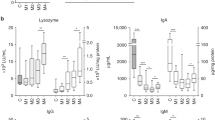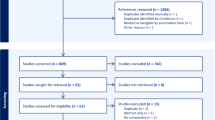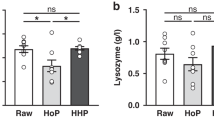Abstract
Objective:
To evaluate the integrity of the human milk (pH, bacterial counts, host defense factors and nutrients) subjected to thawing, warming, refrigeration and maintenance at room temperature.
Study Design:
Mothers in the neonatal intensive care unit donated freshly expressed milk. A baseline sample was stored at −80 °C and the remainder of the milk was divided and stored for 7 days at −20 °C. The milk was then subjected to two methods of thawing and warming: tepid water and waterless warmer. Thawed milk also was refrigerated for 24 h prior to warming. Lastly, warmed milk was maintained at room temperature for 4 h to simulate a feeding session. Samples were analyzed for pH, bacterial colony counts, total fat and free fatty acids, and the content of protein, secretory IgA and lactoferrin. Data were analyzed by repeated-measures analysis of variance and paired t test.
Result:
There were no differences between processing methods and no changes in fat, protein, lactoferrin and secretory immunoglobulin A with processing steps. Milk pH and bacterial colony counts declined while free fatty acids rose with processing. Refrigeration of thawed milk resulted in greater declines in pH and bacteria and increases in free fatty acids. Bacterial colony counts and free fatty acids increased with maintenance at room temperature.
Conclusion:
The integrity of the milk was affected similarly by the two thawing and warming methods. Thawing and warming change the integrity of previously frozen human milk, but not adversely. Concerns about maintaining warmed milk at room temperature need to be explored.
This is a preview of subscription content, access via your institution
Access options
Subscribe to this journal
Receive 12 print issues and online access
$259.00 per year
only $21.58 per issue
Buy this article
- Purchase on Springer Link
- Instant access to full article PDF
Prices may be subject to local taxes which are calculated during checkout





Similar content being viewed by others
References
Academy of Breastfeeding Medicine Protocol Committee, Eglash A. ABM clinical protocol #8: human milk storage information for home use for full-term infants (original protocol March 2004; revision #1 March 2010). Breastfeed Med 2010; 5: 127–130.
O'Gara C, Canahuati J, Martin AM . Every mother is a working mother: breastfeeding and women's work. Int J Gynaecol Obstet 1994; 47: S33–S39.
Slutzah M, Codipilly C, Potak D, Clark RM, Schanler RJ . Refrigerator storage of expressed human milk in the neonatal intensive care unit. J Pediatr 2010; 156: 26–28.
Eckburg JJ, Bell EF, Rios GR, Wilmoth PK . Effects of formula temperature on postprandial thermogenesis and body temperature of premature infants. J Pediatr 1987; 111: 588–592.
Gonzales I, Duryea EJ, Vasquez E, Geraghty N . Effect of enteral feeding temperature on feeding tolerance in preterm infants. Neonatal Netw 1995; 14: 39–43.
Holt LE Jr, Davies EA, Hassel Meyer EG, Adams AO . A study of premature infants fed cold formula. J Pediatr 1962; 61: 556–561.
Anderson CA, Berseth CL . Neither motor responses nor gastric emptying vary in response to formula temperature in preterm infants. Biol Neonate 1996; 70: 265–270.
Clark RM, Ferris AM, Fey M, Brown PB, Hundrieser KE, Jensen RG . Changes in the lipids of human milk from 2-16 weeks postpartum. J Pediatr Gastroenterol Nutr 1982; 1: 311–315.
Hamosh M, Ellis LA, Pollock DR, Henderson TR, Hamosh P . Breastfeeding and the working mother: effect of time and temperature of short-term storage on proteolysis, lipolysis and bacterial growth in milk. Pediatrics 1996; 97 (4): 492–498.
Bertino E, Giribaldi M, Baro C, Giancotti V, Pazzi M, Peila C et al. Effect of prolonged refrigeration on the lipid profile, lipase activity and oxidation status of human milk. J Pediatr Gastroenterol Nutr 2013; 56: 390–396.
Hamosh M, Henderson TR, Ellis LA, Jee-In M, Hamosh P . Digestive enzymes in human milk: stability at suboptimal storage temperatures. J Pediatr Gastroenterol Nutr 1997; 24 (1): 38–43.
Deodhar L, Joshi S . Microbiological study of breast milk with special reference to its storage in milk bank. J Postgrad Med 1991; 37: 14–16.
Hernandez J, Lemons P, Lemons J, Todd J . Effect of storage processes on the bacterial growth-inhibiting activity of human breast milk. Pediatrics 1979; 63: 597–601.
Jocson MAL, Mason EO, Schanler RJ . The effects of nutrient fortification and varying storage conditions on host defense properties of human milk. Pediatrics 1997; 100: 240–243.
Eteng MU, Ebong PE, Eyong EU, Ettarh RR . Storage beyond three hours at ambient temperature alters the biochemical and nutritional qualities of breast milk. Afr J Reprod Health 2001; 5: 130–134.
Acknowledgements
This study was funded in part by Medela.
Author contributions
Drs Handa, Ahrabi, Codipilly, Shah, Schanler, and Ms Potak contributed to the design of the study. Drs Handa and Schanler drafted the manuscript. All authors contributed to the acquisition of the data, and the analyses and interpretation of the data, and the review and approval of the manuscript.
Author information
Authors and Affiliations
Corresponding author
Ethics declarations
Competing interests
The authors declare no conflict of interest.
Rights and permissions
About this article
Cite this article
Handa, D., Ahrabi, A., Codipilly, C. et al. Do thawing and warming affect the integrity of human milk?. J Perinatol 34, 863–866 (2014). https://doi.org/10.1038/jp.2014.113
Received:
Revised:
Accepted:
Published:
Issue Date:
DOI: https://doi.org/10.1038/jp.2014.113
This article is cited by
-
Effects of the thawing rate and heating temperature on immunoglobulin A and lysozyme activity in human milk
International Breastfeeding Journal (2022)
-
Testing the feasibility and safety of feeding preterm infants fresh mother’s own milk in the NICU: A pilot study
Scientific Reports (2019)



